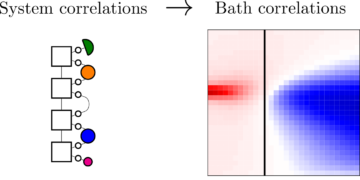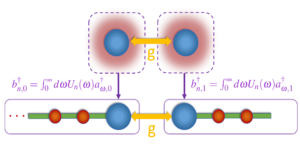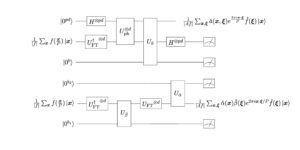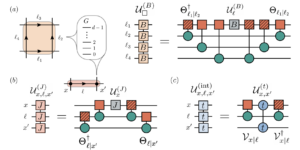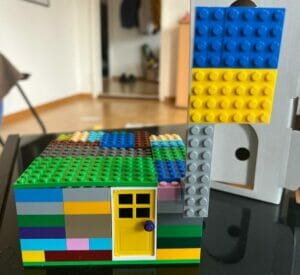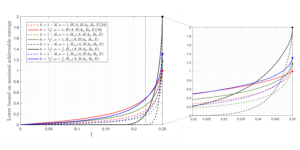QMATH, Department of Mathematical Sciences, University of Copenhagen, Universitetsparken 5, 2100 Copenhagen, Denmark
Find this paper interesting or want to discuss? Scite or leave a comment on SciRate.
Abstract
Discrimination between objects, in particular quantum states, is one of the most fundamental tasks in (quantum) information theory. Recent years have seen significant progress towards extending the framework to point-to-point quantum channels. However, with technological progress the focus of the field is shifting to more complex structures: Quantum networks. In contrast to channels, networks allow for intermediate access points where information can be received, processed and reintroduced into the network. In this work we study the discrimination of quantum networks and its fundamental limitations. In particular when multiple uses of the network are at hand, the rooster of available strategies becomes increasingly complex. The simplest quantum network that capturers the structure of the problem is given by a quantum superchannel. We discuss the available classes of strategies when considering $n$ copies of a superchannel and give fundamental bounds on the asymptotically achievable rates in an asymmetric discrimination setting. Furthermore, we discuss achievability, symmetric network discrimination, the strong converse exponent, generalization to arbitrary quantum networks and finally an application to an active version of the quantum illumination problem.
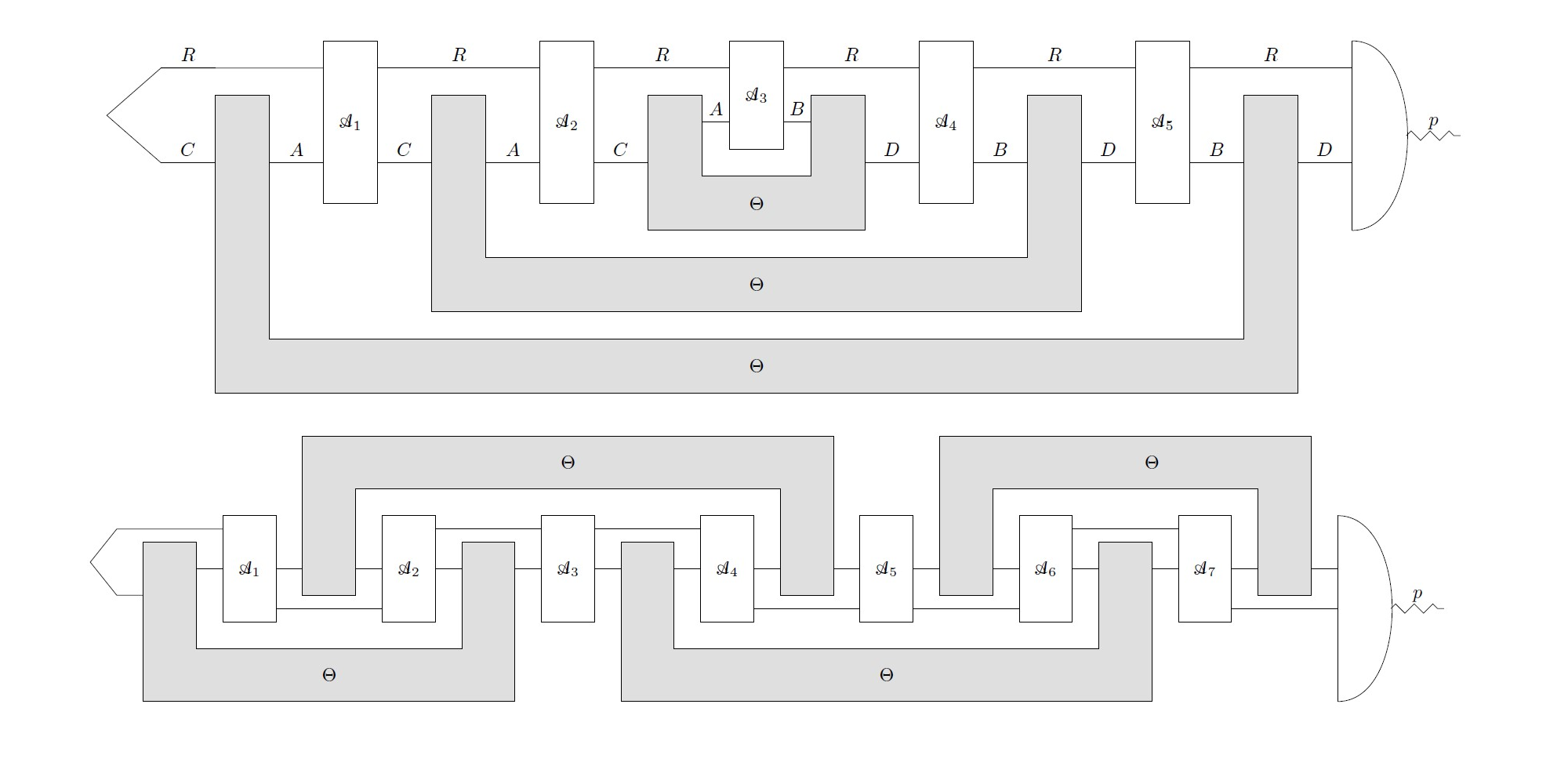
Featured image: The image shows two superchannel discrimination strategies that are unique to this setting and do not make sense when considering simpler settings like point-to-point quantum channels. They exemplify the additional opportunities but also challenges when determining optimal rates for network discrimination.
► BibTeX data
► References
[1] Ligong Wang and Renato Renner. “One-shot classical-quantum capacity and hypothesis testing”. Physical Review Letters 108, 200501 (2012).
https://doi.org/10.1103/PhysRevLett.108.200501
[2] Nilanjana Datta, Milan Mosonyi, Min-Hsiu Hsieh, and Fernando GSL Brandao. “A smooth entropy approach to quantum hypothesis testing and the classical capacity of quantum channels”. IEEE transactions on information theory 59, 8014–8026 (2013).
https://doi.org/10.1109/TIT.2013.2282160
[3] Fernando GSL Brandao, Aram W Harrow, James R Le, and Yuval Peres. “Adversarial hypothesis testing and a quantum stein’s lemma for restricted measurements”. IEEE Transactions on Information Theory 66, 5037–5054 (2020).
https://doi.org/10.1109/TIT.2020.2979704
[4] T. Cooney, C. Hirche, C. Morgan, J. P. Olson, K. P. Seshadreesan, J. Watrous, and M. M. Wilde. “Operational meaning of quantum measures of recovery”. Physical Review A 94, 022310 (2016).
https://doi.org/10.1103/PhysRevA.94.022310
[5] Christoph Hirche, Masahito Hayashi, Emilio Bagan, and John Calsamiglia. “Discrimination power of a quantum detector”. Physical Review Letters 118, 160502 (2017).
https://doi.org/10.1103/PhysRevLett.118.160502
[6] K. M. R. Audenaert, M. Nussbaum, A. Szkoła, and F. Verstraete. “Asymptotic error rates in quantum hypothesis testing”. Communications in Mathematical Physics 279, 251–283 (2008).
https://doi.org/10.1007/s00220-008-0417-5
[7] Mario Berta, Fernando G. S. L. Brandao, and Christoph Hirche. “On composite quantum hypothesis testing”. Commun. Math. Phys. 385, 55–77 (2021).
https://doi.org/10.1007/s00220-021-04133-8
[8] Mark M Wilde, Mario Berta, Christoph Hirche, and Eneet Kaur. “Amortized channel divergence for asymptotic quantum channel discrimination”. Letters in Mathematical Physics 110, 2277–2336 (2020).
https://doi.org/10.1007/s11005-020-01297-7
[9] Xin Wang and Mark M. Wilde. “Resource theory of asymmetric distinguishability for quantum channels”. Physical Review Research 1, 033169 (2019).
https://doi.org/10.1103/PhysRevResearch.1.033169
[10] Kun Fang, Omar Fawzi, Renato Renner, and David Sutter. “A chain rule for the quantum relative entropy”. Phys. Rev. Lett. 124, 100501 (2020).
https://doi.org/10.1103/PhysRevLett.124.100501
[11] Masahito Hayashi. “Discrimination of two channels by adaptive methods and its application to quantum system”. IEEE Transactions on Information Theory 55, 3807–3820 (2009).
https://doi.org/10.1109/TIT.2009.2023726
[12] Mario Berta, Christoph Hirche, Eneet Kaur, and Mark M Wilde. “Stein’s lemma for classical-quantum channels”. In 2019 IEEE International Symposium on Information Theory (ISIT). Pages 2564–2568. IEEE (2019).
https://doi.org/10.1109/ISIT.2019.8849562
[13] Farzin Salek, Masahito Hayashi, and Andreas Winter. “Usefulness of adaptive strategies in asymptotic quantum channel discrimination”. Phys. Rev. A 105, 022419 (2022).
https://doi.org/10.1103/PhysRevA.105.022419
[14] Christoph Hirche. “From asymptotic hypothesis testing to entropy inequalities” (2018). arXiv:1812.05142.
arXiv:1812.05142
[15] Hisaharu Umegaki. “Conditional expectations in an operator algebra, IV (entropy and information)”. Kodai Mathematical Seminar Reports 14, 59–85 (1962).
https://doi.org/10.2996/kmj/1138844604
[16] Dénes Petz. “Quasi-entropies for states of a von Neumann algebra”. Publ. RIMS, Kyoto University 21, 787–800 (1985).
https://doi.org/10.2977/PRIMS/1195178929
[17] Dénes Petz. “Quasi-entropies for finite quantum systems”. Reports in Mathematical Physics 23, 57–65 (1986).
https://doi.org/10.1016/0034-4877(86)90067-4
[18] K. M. R. Audenaert, J. Calsamiglia, R. Muñoz-Tapia, E. Bagan, L. Masanes, A. Acin, and F. Verstraete. “Discriminating states: The quantum Chernoff bound”. Physical Review Letters 98, 160501 (2007).
https://doi.org/10.1103/PhysRevLett.98.160501
[19] Michael Nussbaum and Arleta Szkoła. “The Chernoff lower bound for symmetric quantum hypothesis testing”. The Annals of Statistics 37, 1040–1057 (2009).
https://doi.org/10.1214/08-AOS593
[20] Martin Müller-Lennert, Frédéric Dupuis, Oleg Szehr, Serge Fehr, and Marco Tomamichel. “On quantum Rényi entropies: a new generalization and some properties”. Journal of Mathematical Physics 54, 122203 (2013).
https://doi.org/10.1063/1.4838856
[21] Mark M. Wilde, Andreas Winter, and Dong Yang. “Strong converse for the classical capacity of entanglement-breaking and Hadamard channels via a sandwiched Rényi relative entropy”. Communications in Mathematical Physics 331, 593–622 (2014).
https://doi.org/10.1007/s00220-014-2122-x
[22] Armin Uhlmann. “The “transition probability” in the state space of a *-algebra”. Reports on Mathematical Physics 9, 273–279 (1976).
https://doi.org/10.1016/0034-4877(76)90060-4
[23] Nilanjana Datta. “Min- and max-relative entropies and a new entanglement monotone”. IEEE Transactions on Information Theory 55, 2816–2826 (2009).
https://doi.org/10.1109/TIT.2009.2018325
[24] Rahul Jain, Jaikumar Radhakrishnan, and Pranab Sen. “Privacy and interaction in quantum communication complexity and a theorem about the relative entropy of quantum states”. In Proceedings of the 43rd Annual IEEE Symposium on Foundations of Computer Science. Pages 429–438. (2002).
https://doi.org/10.1109/SFCS.2002.1181967
[25] Debbie Leung and William Matthews. “On the power of PPT-preserving and non-signalling codes”. IEEE Transactions of Information Theory 61, 4486–4499 (2015).
https://doi.org/10.1109/TIT.2015.2439953
[26] Xin Wang, Kun Fang, and Runyao Duan. “Semidefinite programming converse bounds for quantum communication”. IEEE Transactions on Information Theory 65, 2583–2592 (2019).
https://doi.org/10.1109/TIT.2018.2874031
[27] Eric Chitambar and Gilad Gour. “Quantum resource theories”. Reviews of Modern Physics 91, 025001 (2019).
https://doi.org/10.1103/RevModPhys.91.025001
[28] Giulio Chiribella, Giacomo Mauro D’Ariano, and Paolo Perinotti. “Theoretical framework for quantum networks”. Physical Review A 80, 022339 (2009).
https://doi.org/10.1103/PhysRevA.80.022339
[29] Gilad Gour. “Comparison of quantum channels with superchannels”. IEEE Transactions on Information Theory 65, 5880–5904 (2019).
https://doi.org/10.1109/TIT.2019.2907989
[30] Giulio Chiribella, Giacomo Mauro D’Ariano, and Paolo Perinotti. “Transforming quantum operations: Quantum supermaps”. EPL (Europhysics Letters) 83, 30004 (2008).
https://doi.org/10.1209/0295-5075/83/30004
[31] A. Bisio, G. Chiribella, G. M. D’Ariano, and P. Perinotti. “Quantum Networks: General Theory and Applications”. Acta Physica Slovaca 61, 273–390 (2011).
https://doi.org/10.2478/v10155-011-0003-9
[32] Alessandro Bisio, Giacomo Mauro D’Ariano, Paolo Perinotti, and Giulio Chiribella. “Minimal computational-space implementation of multiround quantum protocols”. Physical Review A 83, 022325 (2011).
https://doi.org/10.1103/PhysRevA.83.022325
[33] Gilad Gour and Carlo Maria Scandolo. “Dynamical resources” (2020). arXiv:2101.01552.
arXiv:2101.01552
[34] Giulio Chiribella, Giacomo M D’Ariano, and Paolo Perinotti. “Memory effects in quantum channel discrimination”. Physical review letters 101, 180501 (2008).
https://doi.org/10.1103/PhysRevLett.101.180501
[35] Kenji Nakahira and Kentaro Kato. “Simple upper and lower bounds on the ultimate success probability for discriminating arbitrary finite-dimensional quantum processes”. Physical Review Letters 126, 200502 (2021).
https://doi.org/10.1103/PhysRevLett.126.200502
[36] Carl W. Helstrom. “Quantum detection and estimation theory”. Journal of Statistical Physics 1, 231–252 (1969).
https://doi.org/10.1007/BF01007479
[37] Alexander S. Holevo. “Statistical decision theory for quantum systems”. Journal of Multivariate Analysis 3, 337–394 (1973).
https://doi.org/10.1016/0047-259X(73)90028-6
[38] Carl W. Helstrom. “Quantum detection and estimation theory”. Academic. New York (1976).
[39] Tom Cooney, Milán Mosonyi, and Mark M. Wilde. “Strong converse exponents for a quantum channel discrimination problem and quantum-feedback-assisted communication”. Communications in Mathematical Physics 344, 797–829 (2016).
https://doi.org/10.1007/s00220-016-2645-4
[40] Yury Polyanskiy and Sergio Verdú. “Arimoto channel coding converse and Rényi divergence”. In Proceedings of the 48th Annual Allerton Conference on Communication, Control, and Computation. Pages 1327–1333. (2010).
https://doi.org/10.1109/ALLERTON.2010.5707067
[41] Naresh Sharma and Naqueeb Ahmad Warsi. “On the strong converses for the quantum channel capacity theorems”. Phys. Rev. Lett. 110, 080501 (2012).
https://doi.org/10.1103/PhysRevLett.110.080501
[42] Hamza Fawzi and Omar Fawzi. “Defining quantum divergences via convex optimization”. Quantum 5, 387 (2020).
https://doi.org/10.22331/q-2021-01-26-387
[43] Kun Fang and Hamza Fawzi. “Geometric Rényi divergence and its applications in quantum channel capacities”. Communications in Mathematical Physics 384, 1615–1677 (2021).
https://doi.org/10.1007/s00220-021-04064-4
[44] Fumio Hiai and Dénes Petz. “The proper formula for relative entropy and its asymptotics in quantum probability”. Communications in Mathematical Physics 143, 99–114 (1991).
https://doi.org/10.1007/BF02100287
[45] Marco Tomamichel and Masahito Hayashi. “A hierarchy of information quantities for finite block length analysis of quantum tasks”. IEEE Transactions on Information Theory 59, 7693–7710 (2013).
https://doi.org/10.1109/TIT.2013.2276628
[46] Ke Li et al. “Second-order asymptotics for quantum hypothesis testing”. The Annals of Statistics 42, 171–189 (2014).
https://doi.org/10.1214/13-AOS1185
[47] Milán Mosonyi and Tomohiro Ogawa. “Quantum hypothesis testing and the operational interpretation of the quantum rényi relative entropies”. Communications in Mathematical Physics 334, 1617–1648 (2015).
https://doi.org/10.1007/s00220-014-2248-x
[48] Milán Mosonyi and Fumio Hiai. “On the quantum rényi relative entropies and related capacity formulas”. IEEE Transactions on Information Theory 57, 2474–2487 (2011).
https://doi.org/10.1109/TIT.2011.2110050
[49] Seth Lloyd. “Enhanced sensitivity of photodetection via quantum illumination”. Science 321, 1463–1465 (2008).
https://doi.org/10.1126/science.11606
[50] Jessica Bavaresco, Mio Murao, and Marco Túlio Quintino. “Strict hierarchy between parallel, sequential, and indefinite-causal-order strategies for channel discrimination”. Physical review letters 127, 200504 (2021).
https://doi.org/10.1103/PhysRevLett.127.200504
[51] Marco Tomamichel. “A framework for non-asymptotic quantum information theory” (2012). arXiv:1203.2142.
arXiv:1203.2142
[52] Andreas Winter. “Open problem session”. Rocky Mountain Summit on Quantum Information (2018).
[53] Zi-Wen Liu and Andreas Winter. “Resource theories of quantum channels and the universal role of resource erasure” (2019). arXiv:1904.04201.
arXiv:1904.04201
[54] Gilad Gour and Andreas Winter. “How to quantify a dynamical quantum resource”. Physical review letters 123, 150401 (2019).
https://doi.org/10.1103/PhysRevLett.123.150401
Cited by
[1] Sumit Rout, Ananda G. Maity, Amit Mukherjee, Saronath Halder, and Manik Banik, “Multiparty orthogonal product states with minimal genuine nonlocality”, Physical Review A 104 5, 052433 (2021).
[2] Kenji Nakahira and Kentaro Kato, “Generalized quantum process discrimination problems”, Physical Review A 103 6, 062606 (2021).
[3] Samrat Sen, Edwin Peter Lobo, Sahil Gopalkrishna Naik, Ram Krishna Patra, Tathagata Gupta, Subhendu B. Ghosh, Sutapa Saha, Mir Alimuddin, Tamal Guha, Some Sankar Bhattacharya, and Manik Banik, “Local quantum state marking”, Physical Review A 105 3, 032407 (2022).
The above citations are from SAO/NASA ADS (last updated successfully 2023-07-25 10:03:14). The list may be incomplete as not all publishers provide suitable and complete citation data.
Could not fetch Crossref cited-by data during last attempt 2023-07-25 10:03:12: Could not fetch cited-by data for 10.22331/q-2023-07-25-1064 from Crossref. This is normal if the DOI was registered recently.
This Paper is published in Quantum under the Creative Commons Attribution 4.0 International (CC BY 4.0) license. Copyright remains with the original copyright holders such as the authors or their institutions.
- SEO Powered Content & PR Distribution. Get Amplified Today.
- PlatoData.Network Vertical Generative Ai. Empower Yourself. Access Here.
- PlatoAiStream. Web3 Intelligence. Knowledge Amplified. Access Here.
- PlatoESG. Automotive / EVs, Carbon, CleanTech, Energy, Environment, Solar, Waste Management. Access Here.
- BlockOffsets. Modernizing Environmental Offset Ownership. Access Here.
- Source: https://quantum-journal.org/papers/q-2023-07-25-1064/
- :is
- :not
- :where
- ][p
- 1
- 10
- 11
- 12
- 13
- 14
- 15%
- 16
- 17
- 19
- 1985
- 20
- 2000
- 2008
- 2011
- 2012
- 2013
- 2014
- 2015
- 2016
- 2017
- 2018
- 2019
- 2020
- 2021
- 2022
- 22
- 23
- 24
- 25
- 26%
- 27
- 28
- 30
- 31
- 32
- 33
- 36
- 385
- 39
- 40
- 49
- 50
- 51
- 66
- 7
- 8
- 80
- 9
- 91
- 98
- a
- About
- above
- ABSTRACT
- academic
- access
- active
- Additional
- affiliations
- AL
- Alexander
- All
- allow
- also
- an
- analysis
- and
- annual
- Application
- applications
- approach
- ARE
- AS
- At
- author
- authors
- available
- BE
- becomes
- between
- Block
- Bound
- Break
- but
- by
- CAN
- capacities
- Capacity
- Carl
- chain
- challenges
- Channel
- channels
- classes
- codes
- Coding
- comment
- Commons
- Communication
- Communications
- complete
- complex
- complexity
- computation
- computer
- computer science
- Conference
- considering
- contrast
- control
- Convex
- copyright
- could
- data
- David
- Debbie
- decision
- Department
- Detection
- determining
- discuss
- Divergence
- do
- during
- e
- E&T
- Edwin
- effects
- entanglement
- error
- expectations
- extending
- field
- Finally
- Focus
- For
- formula
- Foundations
- Framework
- from
- fundamental
- Furthermore
- General
- genuine
- Give
- given
- hand
- harvard
- Have
- hierarchy
- holders
- However
- HTTPS
- IEEE
- if
- image
- implementation
- in
- increasingly
- inequalities
- information
- institutions
- interaction
- interesting
- International
- interpretation
- into
- ITS
- james
- JavaScript
- John
- journal
- Last
- Leave
- lemma
- Length
- Li
- License
- like
- limitations
- List
- local
- lower
- make
- Marco
- maria
- mario
- mark
- marking
- Martin
- math
- mathematical
- max-width
- May..
- meaning
- measurements
- measures
- methods
- Michael
- MILAN
- minimal
- Mir
- Modern
- Month
- more
- Morgan
- most
- Mountain
- Mukherjee
- multiple
- network
- networks
- New
- New York
- normal
- objects
- of
- omar
- on
- ONE
- open
- operational
- Operations
- operator
- opportunities
- optimal
- optimization
- or
- original
- pages
- Paolo
- Paper
- Parallel
- particular
- Peter
- physical
- Physics
- plato
- Plato Data Intelligence
- PlatoData
- points
- power
- Problem
- problems
- Proceedings
- process
- Processed
- processes
- Product
- Programming
- Progress
- proper
- properties
- protocols
- provide
- published
- publisher
- publishers
- Quantum
- quantum information
- quantum networks
- quantum systems
- R
- RAM
- Rates
- received
- recent
- recently
- recovery
- references
- registered
- related
- relative
- remains
- Reports
- research
- resource
- Resources
- restricted
- review
- Reviews
- rocky
- Role
- Rout
- Rule
- s
- Science
- SCIENCES
- seen
- seminar
- sense
- Sensitivity
- session
- setting
- settings
- Sharma
- SHIFTING
- Shows
- significant
- simpler
- smooth
- some
- Space
- State
- States
- statistical
- statistics
- strategies
- strong
- structure
- Study
- success
- Successfully
- such
- suitable
- Summit
- Symposium
- system
- Systems
- tasks
- technological
- Testing
- that
- The
- The State
- their
- theory
- they
- this
- Title
- to
- tom
- towards
- Transactions
- two
- ultimate
- under
- unique
- Universal
- university
- updated
- URL
- uses
- version
- via
- volume
- von
- W
- want
- was
- we
- when
- Winter
- with
- Work
- year
- years
- york
- zephyrnet




